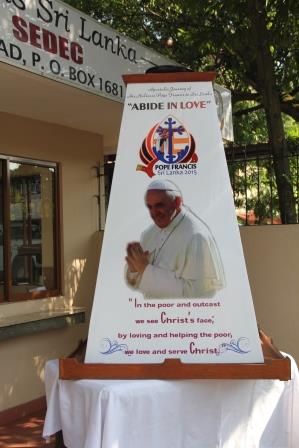Sri Lanka elections: peace and reconciliation
 As Pope Francis calls for reconciliation in Sri Lanka, Joe William from CAFOD partner Centre for Communications Training reflects on last week’s Presidential election.
As Pope Francis calls for reconciliation in Sri Lanka, Joe William from CAFOD partner Centre for Communications Training reflects on last week’s Presidential election.
Please pray for peace and reconciliation in Sri Lanka
After the end of the war in 2009, a rainbow coalition of political parties now provides the best option for sustainable peace and reconciliation in Sri Lanka.
The contest for the island’s eighth Presidential Election began in November when incumbent Rajapaksa called snap polls, two years ahead of schedule. With no serious contender at that time, he was eyeing an unprecedented third term in office, least expecting his own Cabinet Minister Maithripala Sirisena to defect and emerge as a common candidate who would win the support of an eclectic joint opposition platform.
Mr. Sirisena’s departure not only prompted some of his colleagues to move with him, but also caused quite a flutter in the ruling camp. The subsequent turn of events — importantly, Tamil and Muslim parties pledging support to Mr. Sirisena — led to what was one of the most closely fought presidential elections in Sri Lanka’s history.
Confident supporters of Mr. Rajapaksa argued that it would be hard to match the two-time President in charisma or mass appeal as he won the war waged against the LTTE [Tamil Tigers]. However, five years after the military victory over the LTTE, the President’s war victor image has been waning. Concerns over corruption, apparently rising authoritarianism and dominance of his family, have outweighed people’s appreciation for his development initiatives by way of plush highways, ports and airports for the country.
The comparable backgrounds of the two leaders intensified the contest. Mr. Rajapaksa, 69, belongs to rural Hambantota, at the heart of the island’s southern Sinhalese belt, while Mr. Sirisena, 63, hails from the peasant community in the ancient town of Polonnaruwa, the rice bowl of Sri Lanka. If Mr. Rajapaksa employed the rhetoric of war victory while addressing his Sinhalese electorate, Mr. Sirisena resorted to promises of abolishing the country’s much-criticised Executive Presidency.
Both tread on the question of political rights of Tamils with evident reservation, perhaps for the fear of alienating their majority constituency. Unlike in several other elections, the nationalist ideology was not the dominant theme framing the discourse of this election. Good Governance, as a campaign point encapsulated the critique of abuse of power and corruption, combining it with a strong desire for change in style of administration.
High stakes
This Presidential Election was different from all the electoral contests since Independence. One camp backed by various forces, internal and external, striving for a regime change through electoral means while the other resisting that move tooth and nail. The two main candidates were backed by parties which have a propensity for violence as seen during the past several decades leading to a severe erosion of public faith in the electoral system. Their stakes in the contest were extremely high. So, they went flat out to win regardless of the methods used. Inflammatory, hate-mongering rhetoric continued to be disseminated via the social media’s rules.
The government used this election to revive the memory of the war. The government claimed that the LTTE was still alive in the Tamil Diaspora, which is supported by Western governments who wished to see Sri Lanka divided. Due to one-sided propaganda, many Sinhalese people were worried that this danger was a real one. This swayed a large number of less urban Sinhalese voters to want the President to remain in power. It was notable that the former President was able to have the edge in almost all areas in which the Sinhalese were the predominant community. We have to also recognise that the people did not overwhelmingly vote for Sirisena. In fact a large percentage of Sinhalese did not vote for him. There was no landslide. It was the Tamil and Muslim vote that helped him to win.
Keen interest
The public evinced a keen interest in the Presidential Election as never before and the voter turnout was reported to be 80 percent. The successful GoVote campaign carried out by CAFOD partner NPC helped to convince people – particularly in the north and east – to take part. One marked feature of this Presidential Election was a near total absence of violence on elections day. The police had been deployed in sufficient numbers on election duty and the public largely co-operated with them to maintain law and order.
Sri Lanka’s former President Chandrika Kumaratunga teamed up with opposition leader Ranil Wickremesinghe to be the chief architects behind the ‘Rainbow Coalition’, whose candidate Maithripala Sirisena challenged incumbent Mahinda Rajapaksa in Presidential Elections. The voters delivered their verdict and prevented him from obtaining his dream third term. He has already made way for his chief rival Maithripala Sirisena and Ranil Wickremasinghe has been appointed Prime Minister.
Peace and reconciliation
Peaceful acceptance of the election results and the speed of the democratic transition have prevented the country’s image being tarnished internationally. Sirisena took his oaths as President on Friday and thereafter appointed Wickremesinhe as Prime Minister. The challenge now is for the new President and newly appointed Prime Minister Ranil Wickremasinghe to prepare for parliamentary polls – expected in June.
If this rainbow coalition can cement their relations, it will provide the best opportunity to move towards lasting peace and reconciliation which have eluded the island nation during the tenure of the outgoing President. A less confrontational model of cooperation needs to be developed with other parties joining hands with the single-largest party and form a government. This will be a triumph for parliamentary democracy.